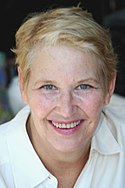Annie Dillard Quote
Say you could view a time-lapse film of our planet: what would you see? Transparent images moving through light, an infinite storm of beauty. The beginning is swaddled in mists, blasted by random blinding flashes. Lava pours and cools; seas boil and flood. Clouds materialize and shift; now you can see the earth’s face through only random patches of clarity. The land shudders and splits, like pack ice rent by a widening lead. Mountains burst up, jutting and dull and soften before your eyes, clothed in forests like felt. The ice rolls up, grinding green land under water forever; the ice rolls back. Forests erupt and disappear like fairy rings. The ice rolls up-mountains are mowed into lakes, land rises wet from the sea like a surfacing whale- the ice rolls back. A blue-green streaks the highest ridges, a yellow-green spreads from the south like a wave up a strand. A red dye seems to leak from the north down the ridges and into the valleys, seeping south; a white follows the red, then yellow-green washes north, then red spreads again, then white, over and over, making patterns of color too swift and intricate to follow. Slow the film. You see dust storms, locusts, floods, in dizzying flash frames. Zero in on a well-watered shore and see smoke from fires drifting. Stone cities rise, spread, and then crumble, like patches of alpine blossoms that flourish for a day an inch above the permafrost, that iced earth no root can suck, and wither in a hour. New cities appear, and rivers sift silt onto their rooftops; more cities emerge and spread in lobes like lichen on rock. The great human figures of history, those intricate, spirited tissues that roamed the earth’s surface, are a wavering blur whose split second in the light was too brief an exposure to yield any images. The great herds of caribou pour into the valleys and trickle back, and pour, a brown fluid. Slow it down more, come closer still. A dot appears, like a flesh-flake. It swells like a balloon; it moves, circles, slows, and vanishes. This is your life.
Say you could view a time-lapse film of our planet: what would you see? Transparent images moving through light, an infinite storm of beauty. The beginning is swaddled in mists, blasted by random blinding flashes. Lava pours and cools; seas boil and flood. Clouds materialize and shift; now you can see the earth’s face through only random patches of clarity. The land shudders and splits, like pack ice rent by a widening lead. Mountains burst up, jutting and dull and soften before your eyes, clothed in forests like felt. The ice rolls up, grinding green land under water forever; the ice rolls back. Forests erupt and disappear like fairy rings. The ice rolls up-mountains are mowed into lakes, land rises wet from the sea like a surfacing whale- the ice rolls back. A blue-green streaks the highest ridges, a yellow-green spreads from the south like a wave up a strand. A red dye seems to leak from the north down the ridges and into the valleys, seeping south; a white follows the red, then yellow-green washes north, then red spreads again, then white, over and over, making patterns of color too swift and intricate to follow. Slow the film. You see dust storms, locusts, floods, in dizzying flash frames. Zero in on a well-watered shore and see smoke from fires drifting. Stone cities rise, spread, and then crumble, like patches of alpine blossoms that flourish for a day an inch above the permafrost, that iced earth no root can suck, and wither in a hour. New cities appear, and rivers sift silt onto their rooftops; more cities emerge and spread in lobes like lichen on rock. The great human figures of history, those intricate, spirited tissues that roamed the earth’s surface, are a wavering blur whose split second in the light was too brief an exposure to yield any images. The great herds of caribou pour into the valleys and trickle back, and pour, a brown fluid. Slow it down more, come closer still. A dot appears, like a flesh-flake. It swells like a balloon; it moves, circles, slows, and vanishes. This is your life.
Related Quotes
About Annie Dillard
